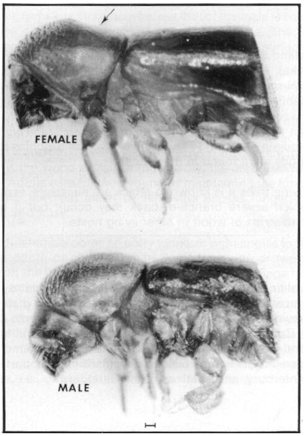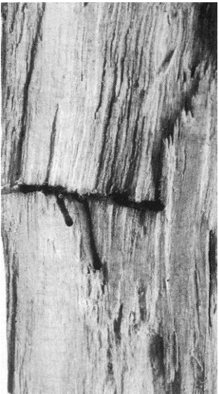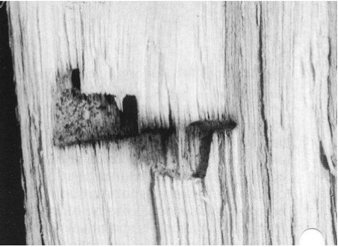PESTS AND DISEASES OF FORESTRY IN NEW ZEALAND
Amasa truncata, introduced ambrosia beetle
Scion is the leading provider of forest-related knowledge in New Zealand
Formerly known as the Forest Research Institute, Scion has been a leader in research relating to forest health for over 50 years. The Rotorua-based Crown Research Institute continues to provide science that will protect all forests from damage caused by insect pests, pathogens and weeds. The information presented below arises from these research activities.
Forest and Timber Insects in New Zealand No. 21: Amasa truncata
Revised 2009
Limited revision 2003
Based on R. Zondag (1977)
Insect: Amasa truncata (Erichson)* (Coleoptera: Scolytidae)
* formerly known as Xyleborus truncatus.

Fig. 1 - Amasa truncata adults. Arrow indicates the part of the thorax which is straight in the female.
The line shows natural length.
Type of injury
Amasa truncata bores small holes in hardwood trees, penetrating to a depth of 30 mm. A brood chamber is usually present at the end of each tunnel. Sapwood is stained black by an ambrosia fungus introduced by the beetle, and discolouration may extend for a considerable distance in live trees. Wilting of foliage and dieback of branches can occur in Eucalyptus globulus.
Hosts
In New Zealand A. truncata has been found breeding in: Kunzea ericoides (kanuka), Leptospermum scoparium (manuka), Knightia excelsa (rewarewa), Metrosideros robusta (northern rata), M. excelsa (pohutukawa), Weinmannia racemosa (kamahi), Eucalyptus globulus, E. botryoides, E. obliqua, E. ovata, E. viminalis, Acacia verticillata, A. decurrens var. mollis , and Albizia lophantha. It has also been recorded in sawn timber of Prumnopitys taxifolia (matai), Pinus radiata (radiata pine), and Pseudotsuga menziesii (Douglas fir) but no developing broods were found in these hosts.
The only living trees it is known to attack are eucalypts, especially E. globulus, in which severe branch-dieback may occur, but it has been recorded in dead strips of wood in other living hosts.
Distribution
This Australian beetle has probably been in New Zealand since the 1930s when typical dieback was first seen in Canterbury. It is now widespread throughout the North and South Islands.
Economic importance
Amasa truncata is of little economic importance. The only host which suffers is E. globulus, but damage by A. truncata to this species is outweighed by that of the eucalyptus tortoise beetle, Paropsis charybdis. Infestations in green sawn timber for export are of only very minor importance compared with those of other more prevalent species, such as Xyleborinus saxeseni.
Description, life history, and habits
The adults are light-brown, cylindrical, and rather broad in proportion to their length (Fig. 1). They are 3 mm long and 1.5 mm wide. The rear ends of the elytra (wing cases) are sharply truncated at an angle of about 75 degrees. The thorax, which is about three-quarters the length of the elytra, is parallel-sided and rounded in front. The folded hind wings of the female can be seen as dark spots through the rear part of the elytra. The male has no dark spots since it has no hind wings. In side view the rear half of the thorax of the female is straight, whereas that of the male is convex. The eyes of the male are narrower than those of the female. The males seldom emerge from the nest but occasionally crawl over the surface of the wood. The larvae are small curved grubs without legs.
Amasa truncata, like the native Platypus species, is an ambrosia beetle. In this group of insects the female introduces into the tree a fungus which develops on the tunnel walls and provides food for the larvae and adults. The wood must have an adequate moisture content for the fungus to grow and if the wood dries out too rapidly, the ambrosia fungus and the larvae die. Adults care for their young by maintaining the fungus in the nest and keeping the nest clean by removing excess fungal growth, wood-scrapings, and frass.
The adult female bores an entry tunnel at right angles to the grain of the wood to a depth of about 30mm. Sometimes one or two short tunnels branch from the main tunnel (Fig. 2). The wood-scrapings from the tunnel wall are ejected through the entrance hole. At one point along this entry tunnel, usually near the inner end, the female makes a small excavation in which the eggs are laid. When the larvae hatch they expand this into a "keyhole chamber" (Fig. 3). It is not known if the female assists in extending this chamber, which is nearly always constructed above the entry tunnel and is rarely more than 25 mm long, approximately 15 mm high, and barely 2 mm wide, i.e., only slightly wider than the female.
In a nest, larvae of various sizes can be found as well as pupae and even young adults, indicating that eggs are laid over a long period. The female that initiated the nest is often found blocking the entrance. This she does very effectively as she is almost the same diameter as the tunnel.
Most of the larvae develop into females which, after mating within the nest, emerge through the entry tunnel. The flightless males rarely emerge. Most emergence is in spring and summer.

Fig. 2 - Entry tunnel made by female A. truncata in Eucalyptus globulus . (x2).

Fig. 3 - Keyhole chamber made by A. truncata in E. globulus .
The black staining is caused by an ambrosia fungus on which larvae and adults feed. (x2).
Much remains to be discovered about this insect in New Zealand and it is difficult to obtain large numbers of specimens for study. It is not known how many progeny are produced from a nest, nor how long the insect takes to complete its life cycle from egg to adult. The life cycle appears to be shorter than a year and two generations may occur in one year.
Most of the observations on its habits have been made on E. globulus branch material and on dead manuka and kanuka. Attack by A. truncata on E. globulus is followed by rapid wilting of the foliage, and it is probable that a fungus (other than the ambrosia fungus) plays a major part in killing the sapwood. In many hardwoods A. truncata is often found in association with Xyleborinus saxeseni, another introduced ambrosia beetle.
Control
There is no need for control measures at present because damaging attack has occurred only on a host of little economic importance.
No predators or parasites have been recorded in New Zealand.
Bibliography
Zondag, R. 1977: Xyleborus truncatus Erichson, (Coleoptera: Scolytidae). New Zealand Forest Service, Forest and Timber Insects in New Zealand No. 21.
This information is intended for general interest only. It is not intended to be a substitute for specific specialist advice on any matter and should not be relied on for that purpose. Scion will not be liable for any direct, indirect, incidental, special, consequential or exemplary damages, loss of profits, or any other intangible losses that result from using the information provided on this site.
(Scion is the trading name of the New Zealand Forest Research Institute Limited.)

 Farm Forestry New Zealand
Farm Forestry New Zealand

